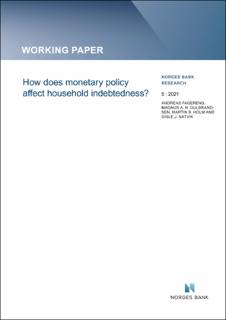| dc.contributor.author | Fagereng, Andreas | |
| dc.contributor.author | Gulbrandsen, Magnus A. H. | |
| dc.contributor.author | Holm, Martin B. | |
| dc.contributor.author | Natvik, Gisle J. | |
| dc.date.accessioned | 2021-09-28T05:56:07Z | |
| dc.date.available | 2021-09-28T05:56:07Z | |
| dc.date.issued | 2021 | |
| dc.identifier.isbn | 978-82-8379-200-3 | |
| dc.identifier.issn | 1502-8190 | |
| dc.identifier.uri | https://hdl.handle.net/11250/2783864 | |
| dc.description.abstract | Households’ debt-to-income ratios change due to (a) primary deficits or (b) "Fisher effects" from interest costs, income growth, and inflation. With Norwegian micro data, we estimate how monetary policy affects household indebtedness by debt levels. In response to interest rate hikes, channel (a) pulls debt-to-income ratios down while channel (b) pushes debt-to-income ratios up. Channel (a) dominates even among highly indebted households where Fisher effects are forceful. However, among indebted households with high unemployment risk, we find no discernible effect on debt-to-income ratios, indicating that monetary policy has limited potential to contain debt where the largest risks are concentrated. | en_US |
| dc.language.iso | eng | en_US |
| dc.publisher | Norges Bank | en_US |
| dc.relation.ispartofseries | Working Paper;5/2021 | |
| dc.rights | Attribution-NonCommercial-NoDerivatives 4.0 Internasjonal | * |
| dc.rights.uri | http://creativecommons.org/licenses/by-nc-nd/4.0/deed.no | * |
| dc.title | How does monetary policy affect household indebtedness? | en_US |
| dc.type | Working paper | en_US |
| dc.description.version | publishedVersion | en_US |
| dc.subject.nsi | VDP::Samfunnsvitenskap: 200::Økonomi: 210::Samfunnsøkonomi: 212 | en_US |
| dc.source.pagenumber | 24 | en_US |

